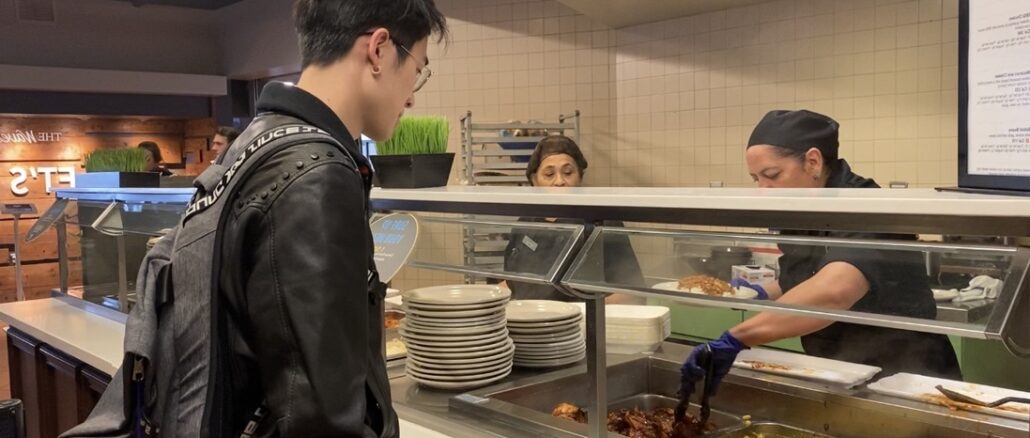
Nicky Ma, a junior philosophy major from Hong Kong, said he greatly misses food from home.
Ma eats outside of campus at least three times a week because the Chinese food he finds in the Waves Cafe is unfulfilling and most of what he encounters is American or Mexican food.
Ma also thinks about food from home everyday.
“It’s affecting my happiness degree by maybe 30%,” Ma said.
He’s not alone. A Pepp Post poll of 52 international students showed that roughly 80% said they are homesick for their culture’s food and only about 30% said they have seen their culture’s food in the cafeteria.
Sodexo Catering Services is aware of this problem and works hard to cater to the dietary needs and preferences of all students by renewing the menu weekly to avoid boredom, General Manager John Fisher said.
“You know, regardless of who is here dining, we really try to provide as much variety as possible,” Fisher said. “And the more variety we can get from a global and international standpoint, the better it’s gonna be for everybody, not only for our international students but our domestic students as well.”
International students’ opinions about Pepperdine’s cafeteria
The poll found that only about 11% of international students generally approve of the cafeteria food and roughly 55% like it sometimes.
However, the poll showed that only about 32% of the international students have seen their ethnic food in the cafeteria.
“I think it’s pretty decent,” Hartono said. “There’s a wide array of cuisines but not so much on the Asian side, so sometimes I get frustrated because most of it is just Mexican food or white people food.”
Olivia Larkin, senior nutritional science major from Australia, said she recognizes the effort that the cafeteria puts into their food.
“As a nutritional science major I worked at the Caf for food service management,” Larkin said. “So like I saw all the hard work that goes into creating the food. I think compared to a lot of other schools we have quite a good Caf.”
Michael Hui, senior business administration major from Hong Kong, thinks that the cafeteria lacks variation in their menu.
“It’s not a lot of variety,” Hui said. “If I take it as like workout food, I could eat it but there’s just not like, it’s unheard of for universities to have food that are not tasty.”
Kimmy Gozan, a senior business administration major from Indonesia, thinks the cafeteria satisfies her dietary needs.
“Yes,” Gozan said. “I could eat basically anything, pizza, salad, rice, omelette place, and a lot of things.”
Fisher said dining services tries to create as much variety from a global and international standpoint as possible and sometimes hosts special ethnic food events.
“We also do our best to provide a different mix and blend of international cuisines that are comfort stations, whether that’s Asian, Mediterranean, or Italian or American,” Fisher said.
These efforts appeal to some international students.
Food and homesickness
It is common for international students to struggle to assimilate and acculturate in the “host” food culture, Debra A. McLachlan and Jessica Justice found in a 2009 study. International students encounter many homesickness problems as they enter the U.S., which could lead to adjustment issues and even health problems. The international students in the study said that they eat a predominantly American diet and cooked foods from their culture when experiencing homesickness.
Communication Professor Jennifer Akamine Phillips, who teaches intercultural studies at Pepperdine, said food is very important to culture. Ignoring that would do a disservice to individuals who come from countries where their food is very different to the host country.
“I think it is an expression of the cultural identity,” Phillips said. “We can’t bring all aspects of our culture [when we are visiting another country], but one thing we can do a little bit easier is to share our food and to share cuisine.”
Phillips, who grew up in California with a Chinese and Japanese background, said she craves Asian food regardless of the country she is in.
“I could go a few days without any issues,” Phillips said. “But after those few days I definitely find myself craving certain food, certain flavor, certain spices.”
Phillips advised students to cook their ethnic food themselves and to share what they cook with others as a way to express their culture.
“Learn to make the meals, to get creative,” Phillips said. “Because you can definitely find a lot of these ingredients in other stores that are more local.”
Phillips also advised international students who are experiencing food homesickness to explore food from other cultures.
“Find a good balance of still making sure that you are getting everything that you enjoy and are craving,” Phillips said. “But at the same time giving yourself the opportunity to open up to other types of food.”
Students seek comfort food from home
Harleen Chhabra, sophomore business administration major from Thailand, said the cafeteria could be more accommodating to international students.
“It definitely makes me more homesick,” Chhabra said. “And like also, just because like I don’t get different [varieties] of food, it makes me sick also at the same time, like physically sick.”
The Pepp Post poll found that about 40% of the students get food from ethnic grocery stores and about 76% go to ethnic food restaurants.
Kathleen Sujatno, a senior business administration major from Indonesia, said she cooks a lot of her own ethnic food.
Sujatno buys ingredients from the supermarket and brings seasonings from her hometown.
The poll also showed that more than 52% of the students chose to cook their own food to better suit their dietary preferences.
Larkin is lactose and fructose intolerant and makes most of her own food.
“I think they do a good job of like accomodating to gluten free and vegan and things like that,” Larkin said. “I am actually lactose and fructose intolerant, and fructose is a really really hard one to avoid so I find that I usually have to make my own food anyway, but overall I think that they do a pretty good job.”
International students’ perspective on ethnic food events
One way Sodexo has tried to serve international students is by hosting cultural food events, such as having a Korean barbeque restaurant take over a Caf station.
“From what I’ve heard it was an overwhelming success and they’d like to come back so I’m trying to figure out how we can have that happen again,” Fisher said. “It’s always little things like that that we can do, like pop up events, to kind of spark some interest and have people have some fun.”
However, the poll showed that only about 15% of the students have been to an ethnic food event.
Students said they would be interested in attending but are unaware of them.
“Never, actually I’ve never heard about it,” Sujatno said. “I would probably go if I knew. It would be interesting to know how people outside my country are able to cook my home foods.”
Many students questioned the cafeteria’s ability to make authentic ethnic food.
“It’s definitely good, but I don’t think they could make it,” Hui said. “I don’t think they would make like dim sum that I consider authentic.”
Elaine Gu, a sophomore integrated marketing communication major from China, said the cafeteria used the wrong ingredients and recipe to cook her traditional dish.
“It tastes good, not bad,” Gu said. “But it’s just not that thing.”
Irma Dewi Tanoesoedibjo, a senior business administration major from Indonesia, also said that food from home just tastes different from elsewhere.
Phillips said it would be helpful to have students or staff who really eat the food from whatever country is being represented to be a part of the food making process because they are more used to the flavors and know what it’s supposed to taste like.
“I think that would be so helpful for the students to feel like they’re getting something a little more authentic,” Phillips said.
Students may be skeptical about the cafeteria’s ability to produce authentic ethnic food, but the poll showed that more than 62% of the students appreciate their efforts to create more culturally diverse dishes.
Samantha Hartono, a senior psychology major from Indonesia, said the cafeteria’s effort to make her home food made her feel like she was at home.
“I remember there was this one time they had Indonesian cuisine,” Hartono said. “Though it didn’t taste that great, but just bringing our culture into the Pepperdine community really made me feel like I was at home.”
Sodexo has to put in extra money and effort to make ethnic food events happen for the students.
“It’s always a challenge to make sure that we can get the product that we need,” Fisher said. “Especially if it’s things that we don’t normally carry, so we kind of have to do the research ahead of time to make sure that we can find the outsourcing of vendors that we can get those particular items in and make sure we get enough of them in.”
Sodexo works to satisfy the dietary needs of all students.
“As we are coming to find in this day and age, it’s very difficult.” Fisher said. “We take [different kinds of dietary needs] into consideration so that we can not only provide a blanket of variety but also enough things for everyone to be able to choose from and be satisfied. It’s difficult, it really is, but it’s a challenge that we’re up for.”
Dining services ask for suggestions from students to improve cafeteria
Fisher said students can drop their suggestions through email, by talking to any of the managers or by going to the dining service office.
“Let us know, we are open to hear every and all feedback.” Fisher said. “Things that you like, things that you don’t like, things that you want to see. The more people that come to us the better it is because it allows us to really hear what we might be missing, or hear what we’re doing well.”
Baby Vanessa completed the reporting for this story in Jour 241 in Fall 2021 under the supervision of Dr. Christina Littlefield and Dr. Theresa de los Santos. Dr. Littlefield supervised the web version of the story.




